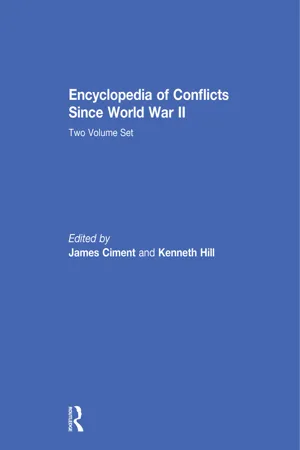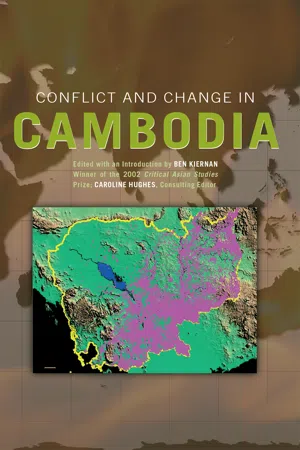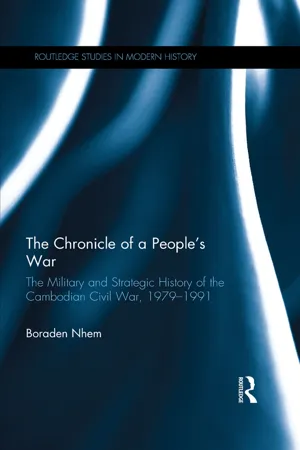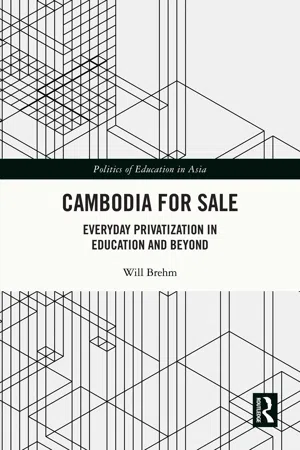Cambodian Civil War
The Cambodian Civil War was a conflict that took place from 1967 to 1975 between the government of Cambodia and the communist Khmer Rouge forces. The war resulted in widespread devastation and loss of life, and ultimately led to the rise of the Khmer Rouge regime, which imposed a brutal and repressive rule over Cambodia.
8 Key excerpts on "Cambodian Civil War"
- eBook - ePub
- James Ciment, Kenneth Hill, James Ciment, Kenneth Hill(Authors)
- 2012(Publication Date)
- Routledge(Publisher)
...Cambodia Civil Wars, 1968–1998 TYPE OF CONFLICT: People's wars; Coups, left and right PARTICIPANTS: United States; Vietnam (North and South) Historical Background Until the thirteenth century, Cambodia was the center of the powerful Khmer Empire, which ruled over an area covering modern Cambodia and large parts of Thailand and Vietnam (Khmer is the ethnic label of the vast majority of Cambodians). But after the fourteenth century, the Khmer Empire collapsed, and subsequent Cambodian kingdoms fell under the sway of either the Thais or the Vietnamese. After 1700, Cambodia was at the mercy of its then stronger neighbors (as it would be again in the twentieth century). What Little independence Cambodia had disappeared with the French conquest, largely complete by 1884. While maintaining complete control of Cambodia's internal affairs, the French kept the Cambodian monarchy as a useful figurehead to aid in their governance of the country. Cambodia's monarchs cooperated, perhaps realizing that French control had saved Cambodia from a possible division between Thailand and Vietnam. Unlike Vietnam, Cambodia offered only minimal resistance to French rule. In 1940, the Japanese occupied all of Indochina, including Cambodia, but left the Vichy French administration in charge of governing the colony until early 1945, when they were replaced by Japanese administrators. When Cambodia's old king, Sisowath Monivong, died in 1941, the French replaced him with his eighteen-year-old grandson Norodom Sihanouk, probably with the hope that he would be a more pliant monarch—a hope that turned out to be misplaced. Sihanouk Although for most of his life he led a playboy lifestyle—enjoying such pastimes as leading a jazz band and directing his own films— Sihanouk gradually grew to be a canny politician...
- eBook - ePub
- Ben Kiernan, Caroline Hughes, Ben Kiernan, Caroline Hughes(Authors)
- 2020(Publication Date)
- Routledge(Publisher)
...Lon Nol’s Khmer Republic quickly lost control of most of the countryside, and U.S. ground troops withdrew in mid-1970, but Saigon forces occupied eastern Cambodia until 1972. Most Vietnamese communist units withdrew from Cambodia in 1973 after the Paris Agreement on Vietnam in January. U.S. aerial bombardments continued and escalated until August 1973. From 1969 to 1973, American aircraft dropped over 2 million tons of bombs on Cambodia’s countryside, killing over 100,000 peasants and driving many survivors into the ranks of the Khmer Rouge. 7 The opposing Cambodian armies fought out the last two years of the war, with continuing large-scale U.S. military assistance to the Republican forces based in the cities, and sporadic Vietnamese aid to the Khmer Rouge who dominated the rural areas, which they called their “bases” (moultanh). After initial urban euphoria, the Khmer Republic became mired in corruption and the increasingly narrow military dictatorship of Lon Nol and his brother Lon Non. In the countryside, portending the genocide to come, the Khmer Rouge central leadership attacked its Vietnamese allies as early as 1970, killed a thousand Khmer communist returnees from Hanoi, and in 1973-74, stepped up violence against ethnic Vietnamese civilians, purged and killed ethnic Thai and other minority members of CPK regional committees, banned an allied group of ethnic Cham Muslim revolutionaries, and instigated severe repression of Muslim communities. On 17 April 1975, Khmer Rouge forces entered Phnom Penh, deported its two million residents into the countryside, and established the new state of Democratic Kampuchea (DK)...
...They abolished private property and replaced paper money by ration tickets earned by productive labour. The Khmer Rouge closed schools and destroyed Buddhist temples. Thousands of people died, including many ethnic Vietnamese. Hundreds of thousands of Vietnamese fled Cambodia. 2 In January 1976 the Khmer Rouge promulgated a new constitution and changed the name of the country to the Democratic Republic of Kampuchea. In April Prince Sihanouk resigned as head of state. Khieu Samphan took his place but Pol Pot, another Khmer Rouge leader, was the dominant figure in the cabinet. Meanwhile the government announced that 800,000 people, roughly 10 per cent of the population, had died in the fighting that brought the Khmer Rouge to power. 3 There had long been border disputes between Vietnam and Cambodia, and by 1977 there was serious fighting. In September Vietnam claimed that four Kampuchean divisions had invaded its Tây Ninh Province. In September and December Vietnam retaliated. In the December incursion 60,000 troops, supported by tanks and artillery, pushed as far as the outskirts of Svay Rieung and Kompong Cham. This led to the first public disclosure of the conflict and an angry radio broadcast on 31 December from Phnom Penh denouncing the Vietnamese. A week later the Vietnamese withdrew, most probably of their own accord, but the Khmer Rouge declared it had won a “historic victory” and rejected calls for negotiations. The Khmer Rouge proceeded to carry out a violent purge centred on its armed forces in the eastern part of the country that were supposed to defend the regime from the Vietnamese. Up to 100,000 Cambodians were executed. Many Khmer Rouge fled into Vietnam to avoid being arrested and killed. Later they formed the backbone of the Vietnamese-sponsored anti-Khmer Rouge resistance. 4 Kampuchea also laid claim to much of southernmost Vietnam (Cochin China) with its large Khmer minority, and to small islands in the Gulf of Thailand...
- eBook - ePub
- Boraden Nhem(Author)
- 2017(Publication Date)
- Routledge(Publisher)
...By simply looking at the reports that were coming in, one can see that the Vietnamese could easily penetrate the rear of the formations and effectively disrupt the Khmer Rouge supplies and artillery support. Once that occurred, the front formations collapsed. One can easily see that the Vietnamese triumphed because of correct tactics, i.e. a blitzkrieg-type tactic. In the mind of the Khmer Rouge leaders, however, when campaigns initially ran so well and then immediately and inexplicably collapsed, this could only mean one thing: internal treachery that was perpetrated by Vietnamese sympathizers. Predictably, Pol Pot went out to destroy the internal enemies. 2.6 Kampuchea Solidarity Front for National Salvation: birth of a revolution 2.6.1 The East Zone put to the sword In June 1977, when the Khmer Rouge was at war with Vietnam, internally, the purges of the cadres in an area along the Cambodian-Vietnamese border, called the East Zone (a Zone was an administrative unit consisting of several provinces), was also under way. A junior Khmer Rouge commander in the East Zone named Hun Sen escaped to Vietnam after learning that his name was next on the execution list. 45 He also wanted to seek support from Vietnam in order to return to Cambodia and defeat the Khmer Rouge. 46 On 27 September, Hun Sen was allowed to meet with Lieutenant General Van Tien Dung, a member of the Politburo of the Vietnamese communist party, who was also the chief of staff of the PAVN. 47 At the end of the meeting, however, no explicit pledge for support was given to Hun Sen. 48 It seemed that as late as 1977, Vietnam still maintained some hope of negotiating with the Khmer Rouge. Perhaps that was the reason why Vietnam did not give any political or military support to the Cambodian refugees who had escaped to Vietnam. For the Khmer Rouge, the year 1978 was eventful. It marked a much larger Khmer Rouge offensive against the Vietnamese...
- eBook - ePub
- David Chandler(Author)
- 2018(Publication Date)
- Routledge(Publisher)
...Over a hundred thousand tons of bombs fell on the Cambodian countryside before the U.S. Congress prohibited further bombing. No reliable estimate of casualties has ever been made, but the campaign probably halted the Communist forces encircling Phnom Penh, even though some have argued that it hardened the will of the surviving Communist forces. The war dragged on for another year and a half, but President Nixon’s reaction to the end of the bombing was to declare to an aide that, as a result, the United States had “lost” Southeast Asia—a section of the world it had never owned. 13 The Communists’ response to over twenty years of Vietnamese assistance to their movement was to massacre most of the Cambodians sent down from North Vietnam as soon as North Vietnamese troops withdrew from Cambodia at the end of 1972, following the cease-fire agreed upon by Vietnam and the United States. These killings occurred in secret. The Communists also experimented with programs of collectivization in the zones under their control, and in early 1973, during the U.S. bombing campaign, the CPK introduced compulsory cooperatives in some areas. By then, rumors were reaching Phnom Penh about the uncompromising conduct of the insurgents, who took no prisoners and who herded inhabitants into the forest whenever they captured a town or village. Many people in Phnom Penh dismissed these rumors as propaganda and continued to believe that the Khmer Rouge were puppets of the Vietnamese. At the same time they were exhausted by the war and ready for almost any alternative to the corrupt and inefficient Khmer Republic. Young girls in revolutionary costume, 1972. Photo by Serge Thion. The end came in early 1975 when the Communists mined the riverine approaches to Phnom Penh and thus prevented shipments of rice and ammunition from reaching the capital. Airlifts arranged by the United States were unable to bring in enough rice to feed Phnom Penh or enough ammunition to defend it...
- eBook - ePub
Cambodia for Sale
Everyday Privatization in Education and Beyond
- Will Brehm(Author)
- 2021(Publication Date)
- Routledge(Publisher)
...Washington, its allies, and foes of the Soviet Union supported these resistance groups figuratively as well as militarily and monetarily. This alliance included Beijing, adding to its improving relations with Washington since the late 1960s. Devastated by war, Cambodia remained isolated within the Western international community. Near the end of the 1980s, the Cambodia “problem” – a term the international community used to describe the country “invaded” by Vietnam with support of the Soviet Union – was nearing a resolution after years of political gridlock among competing interests of the permanent members of the United Nations, the various factions within Cambodia, and the Association of Southeast Asian Nation's (ASEAN's) regional goals in the country (see Song, 1997). The end of Soviet support to Vietnam in 1988, presaging the fall of the Berlin Wall, made an opening for Western powers. The solution, first articulated by US Senator Stephen Solarz and later proposed at the United Nations by Australian foreign minister Gareth Evans, centered on the idea of the United Nations assuming authority over Cambodia as it transitioned to a new government, one based on liberal democracy. Such an intervention in the domestic affairs of a member state never occurred in the history of the United Nations. The United Nations entered Cambodia in the early 1990s for two years, intending to administer complete control of the country under the United Nations Transitional Authority of Cambodia (UNTAC). Even the flag was re-designed: Colored United Nations’ blue with a white image of the Cambodian map on the front. The purpose of this nearly US$2 billion effort was to provide a comprehensive settlement to the then-20-year war in Cambodia...
- eBook - ePub
Brother Number One
A Political Biography Of Pol Pot
- David P Chandler(Author)
- 2018(Publication Date)
- Routledge(Publisher)
...The enemy knew the forests. Wherever we came and went, he was aware of us. We had a few weapons here and there, but we had no land, and no people under our control. 32 As Pol Pot often said, the early stages of the revolution were "waged with empty hands." The phrase is not hyperbolic in view of his assertion in 1977 that the Central Committee in 1968 was protected by four armed men. Although by early 1970 Communist-led guerrilla forces had rendered large parts of the country unsafe for day-to-day administration from Phnom Penh, the military balance of power still favored government forces, and the Communists still depended on captured weapons. It is ironic that the Vietnamese, themselves armed from abroad, should have encouraged a Maoist autonomy for the Khmer as far as weaponry was concerned while insisting on the Khmer's obedience to Vietnam. What drew them to Cambodia (and was later to draw the attention of the United States) were their supply lines into South Vietnam. Insofar as these were threatened by Loii Nol, Sihanouk, and U.S. bombing, the Cambodian Communists and their followers had useful roles to play in providing sentries, laborers, and porters. The Cambodian Communist party's alliance with Vietnam remained in force. In mid-1968, Keo Meas, a high-ranking Cambodian cadre, was dispatched to Hanoi with documents destined for the Cambodian Communists there. Three of the documents—dealing with Samlaut, the people's war, and perceptions of worldwide revolution—were the subjects of a fifteen-day study session for Cambodian Communists in Hanoi...
- eBook - ePub
The End of the Cold War and The Third World
New Perspectives on Regional Conflict
- Artemy Kalinovsky, Sergey Radchenko, Artemy Kalinovsky, Sergey Radchenko(Authors)
- 2011(Publication Date)
- Routledge(Publisher)
...6 From battlefield into marketplace The end of the Cold War in Indochina, 1985–1989 Balázs Szalontai In 1988, recently appointed Thai Premier Chatichai Choonhavan declared his ambition to turn Indochina “from a battlefield into a marketplace.” A retired general with a formidable business acumen, Chatichai was a real personification of this principle. To achieve his aim, Chatichai re-examined his country's Cold War allegiances with breathtaking pragmatism. The exiled Khmer Rouge guerrillas, who used to carry out raids into Cambodia from bases in Thailand, were among the first to be affected by Chatichai's adaptability. In mid-1989, they launched new attacks on the armed forces of the Vietnamese-backed Cambodian Communist regime, only to encounter devastating artillery fire that hit their troops with surprising accuracy. This accuracy reflected not so much the marksmanship of the Cambodian artillerymen but rather the diplomatic flexibility of the Thai leadership. That is, the Thai military, having generously assisted the exiled Khmer Rouge forces for a decade, decided to make a volte-face, and secretly radioed the coordinates of the guerrillas’ positions to the Cambodian general staff. 1 This episode aptly illustrates the dramatic nature of the diplomatic changes which occurred in the three Indochinese countries (Vietnam, Cambodia and Laos) in the final years of the Cold War. Due to its proximity to China, this region constituted a major battlefield of superpower competition from 1950 to 1989, considerably influencing the dynamics of Sino–US and Sino–Soviet relations...







